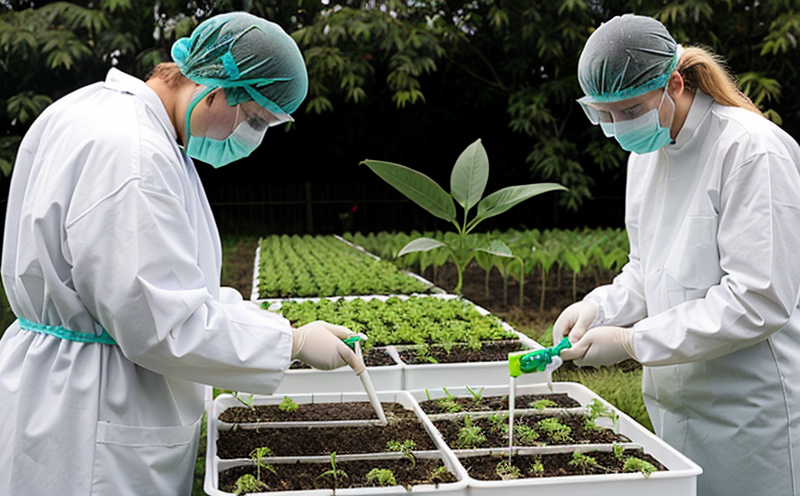Pathogen Load Quantification Testing
The Pathogen Load Quantification Test is a critical procedure used to determine the concentration of specific pathogens present in agricultural and forestry samples. This testing ensures that producers, researchers, and regulatory bodies can accurately quantify pathogen loads, which is essential for effective disease management strategies.
Pathogens such as fungi, bacteria, viruses, and nematodes pose significant risks to crop health and productivity. By quantifying these pathogens, the test provides actionable insights into potential infection levels and helps in implementing targeted interventions that minimize damage while maintaining agricultural output.
The testing process involves several steps. Initially, samples from crops or forest environments are collected and prepared for analysis. The specimens must be free of cross-contamination to ensure accurate results. Once prepared, the samples undergo a series of laboratory procedures designed to isolate and identify the target pathogens.
Advanced molecular techniques like polymerase chain reaction (PCR) and quantitative real-time PCR (qPCR) are commonly used for pathogen detection. These methods allow for precise quantification of specific genetic markers associated with harmful organisms. The instrumentation utilized includes specialized qPCR machines, which can process multiple samples simultaneously, ensuring efficiency and scalability.
The results from these tests are reported in units such as colony-forming units per gram (CFU/g), spores per liter (spores/L), or viral genome copies per milliliter (GC/mL). These measurements provide a clear indication of the pathogen load within the sample, enabling stakeholders to make informed decisions regarding treatment and prevention strategies.
For instance, if a high pathogen load is detected in a crop field, farmers can apply appropriate fungicides or antibiotics. Similarly, in forestry settings, this information helps in choosing suitable biocontrol agents for managing pest populations effectively. The data generated from these tests not only aids in immediate problem-solving but also contributes to broader understanding and improvement of agricultural practices.
The Pathogen Load Quantification Test plays a vital role in ensuring food safety and environmental health. By accurately quantifying pathogen loads, this test supports sustainable agricultural and forestry operations by helping prevent outbreaks that could compromise both human health and ecosystems. This service is particularly valuable for quality managers, compliance officers, R&D engineers, and procurement teams who need reliable data to guide their decision-making processes.
Why Choose This Test
The Pathogen Load Quantification Test offers several advantages over traditional methods of pathogen detection. Firstly, it provides quantitative rather than qualitative results, which is crucial for understanding the extent of contamination and planning appropriate mitigation measures.
- Accurate Quantification: The test allows for precise measurement of pathogen concentrations, enabling accurate tracking of infection levels over time.
- Faster Results: Modern molecular techniques significantly reduce the turnaround time compared to conventional culture-based methods.
- Sensitivity: PCR-based tests can detect extremely low levels of pathogens, making them highly sensitive even in complex samples.
- Specificity: The targeted approach ensures that only relevant pathogens are detected and quantified, minimizing false positives.
In addition to these technical benefits, the Pathogen Load Quantification Test also supports regulatory compliance and enhances reputation among consumers. By demonstrating a commitment to food safety and environmental stewardship, organizations can build trust with customers and regulators alike.
Competitive Advantage and Market Impact
The Pathogen Load Quantification Test offers significant competitive advantages in the agricultural and forestry sectors. By providing accurate and timely data on pathogen loads, businesses can stay ahead of potential outbreaks and respond swiftly to emerging threats.
For example, early detection of pathogens allows for preemptive treatment measures that reduce crop losses and minimize the need for extensive pesticide applications. This approach not only improves yield but also contributes to more sustainable farming practices by reducing environmental impact.
In forestry, timely intervention can prevent the spread of tree diseases, protecting valuable timber resources and biodiversity. The ability to quantify pathogen loads accurately enhances a company’s reputation as a leader in responsible and efficient agricultural management.
Moreover, compliance with international standards such as ISO 16140-2 for fungal isolation and identification ensures that results are recognized globally, opening up opportunities for export markets and fostering international collaboration. The reliability of these tests also supports research efforts aimed at developing new biological control agents and resistance breeding programs.
The demand for safe and sustainable agricultural products continues to grow as consumers become more aware of the importance of food safety and environmental protection. Organizations that invest in robust pathogen quantification testing services position themselves well to meet this growing market trend, thereby gaining a competitive edge in both domestic and international markets.
Use Cases and Application Examples
| Application | Description | Outcome |
|---|---|---|
| Crop Disease Management | Detecting pathogen loads in soil, water, or plant tissues helps farmers identify and manage specific diseases. | Targeted application of fungicides reduces crop losses. |
| Fruit and Vegetable Sanitation | Quantifying pathogens on produce ensures that only safe products reach the market. | Increase in consumer trust and brand loyalty. |
| Forest Health Monitoring | Monitoring pathogen loads in forest ecosystems aids in early disease detection and intervention. | Prevents widespread tree mortality, preserving biodiversity. |
| Agronomy Research | Quantifying pathogen loads supports the development of new plant varieties resistant to specific diseases. | Promotes sustainable breeding programs that enhance crop resilience. |
| Regulatory Compliance | Demonstrating adherence to international standards ensures compliance with legal requirements. | Avoids costly fines and maintains a positive reputation. |
- Certification Programs: Pathogen load quantification is essential for certification programs like Good Agricultural Practices (GAP) and Global GAP, which require evidence of pathogen control measures.
- Supply Chain Integrity: Accurate testing results help ensure that supply chains are free from contaminated products, maintaining integrity throughout the distribution network.
The Pathogen Load Quantification Test is indispensable for ensuring quality and safety in agricultural and forestry operations. Its role extends beyond individual farms and forests to encompass broader implications for public health and environmental conservation.





